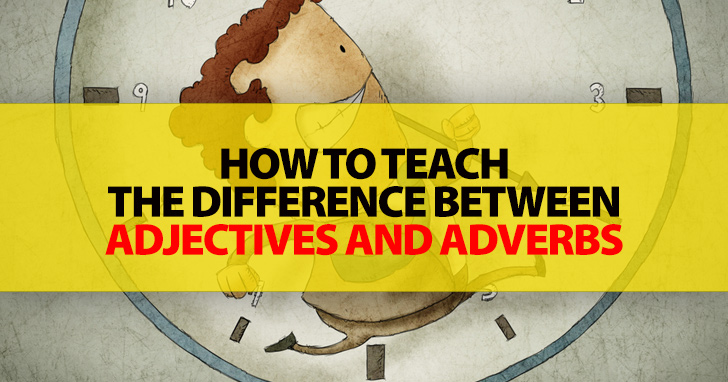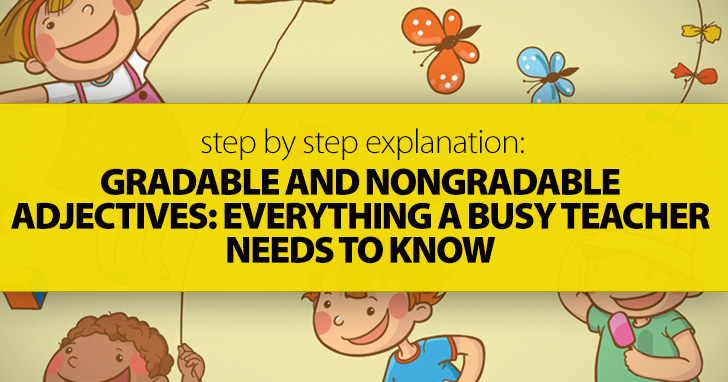How To Teach The Difference Between Adjectives And Adverbs


If you haven’t tackled that subject with your ESL class, here is a step by step explanation of these two types of adjectives and the adverbs that go with them in English.

When I hear the word gradable, it makes me think of report cards and assigning As, Bs, and Cs to a student’s performance in class. In a way, grades on a report card are kind of like gradable adjectives. This subset of English adjectives refers to descriptive words that can express different degrees of a given quality. For example, you might see a girl and think that she is pretty. Well, how pretty is she? Is she fairly pretty? Extremely pretty? Just a bit pretty? Likewise, you might have a friend who falls for every practical joke in the book. That friend is naive, but is he intensely naive? Or just a little naive? These adjectives and others like them can refer to someone or something with a high degree of that quality or a low degree of that quality, all with the same word! Since these are adjectives that can express a range of degree, gradable adjectives can be used in the comparative and superlative forms. When comparing two nouns with a gradable adjective, you might say one house is bigger than the other. If a given item is at the top of the list, you would use the superlative form. That was the hardest test I have ever taken. In both cases, two items are being compared which both possess the quality of that adjective but do so in differing degrees.
Nongradable adjectives, on the other hand, are the opposite of gradable adjectives. They do not describe a quality of various degrees. They are more black and white, yes or no. You either have it or you don’t. To think of the report card analogy, these adjectives are pass/fail. Generally speaking, these adjectives are considered all or nothing. A noun either possesses that quality or it doesn’t. They aren’t used in the comparative or superlative forms because if two items possess that quality, then they both possess it in equal measure (since it’s an all or nothing quality to begin with). For example, deep sea diving without scuba gear is impossible. It sounds strange to ask, “How impossible is it?” It just is impossible. It possesses that all or nothing quality. You also would not say that breathing underwater is more impossible than breathing in outer space since both possess that quality equally.
One particular type of nongradable adjectives are classifying adjectives. Classifying adjectives are those which label their noun as a particular type or as a member of a particular class. Here are some examples of classifying adjectives.
Classifying adjectives do not take comparative or superlative forms. However, sometimes classifying adjectives function as normal (non-classifying) adjectives and can be gradable.
The context of the adjective should be used to determine if it is a classifying adjective or not.
So gradable adjectives are qualities that a person or thing might possess in different measures. Nongradable adjectives are qualities that a person or thing either possesses or doesn’t. There is no varying degree of possession of nongradable adjective. As a result, nongradable adjectives are not used in the comparative and superlative forms. Likewise, English speakers do not use gradable adverbs to modify nongradable adjectives, but they do use them to modify gradable adjectives. What is a gradable adverb? It is an adverb that describes how much of a certain quality (adjective) a noun possesses. Gradable adverbs include a bit, extremely, barely, hardly, and rather. A speaker can, therefore, say, “I am extremely tired,” since tired is a gradable adjective. He would not, however, say, “I am not an extremely native speaker,” because in this sentence native is a classifying adjective and therefore nongradable.
Nongradable adjectives don’t get left out in the cold when it comes to adverbs, however. English possesses nongradable adverbs which can be used with nongradable adjectives but cannot be used with gradable adjectives. Since these adverbs express complete possession of a particular quality, they fit naturally with nongradable adjectives but sound strange with gradable adjectives. Nongradable adverbs include extremely, absolutely, and completely.
One adverb exception is very, which is used consistently with both gradable and nongradable adjectives.
To teach your students the difference between gradable and nongradable adjectives, draw a line across your board and label it with a gradable adjective such as hot. Ask your students to offer different nouns that might be described as hot. When they do, ask how hot those items are and place them on the line as if it were a spectrum. On your line, you might have the sun which is extremely hot, freshly baked bread which is very hot, a cup of coffee which is somewhat hot, and bath water which is a little hot.
Now write the word boiling on the board and draw a line beneath it. Ask your students to offer some nouns which might be described as boiling. As they do, ask them to suggest where on the line these items should go. Your students should realize, and you should point out, that an item is either boiling or it is not. It cannot be graded on the line since it is an all or nothing quality.
If you like, repeat the exercise using these pairs of gradable and nongradable adjectives

To help your students remember the difference between gradable and nongradable adjectives, try this exercise. Have groups of three or four students brainstorm a list of twenty adjectives. Then have them sort the list into gradable and nongradable adjectives. Challenge students to come up with a gradable adjective that has similar meaning to each nongradable adjective and vice versa (as in the examples above). Then have students write ten to fifteen sentences, fill in the blank style, which their classmates will have to complete with either a gradable or nongradable adjective. Make sure students are using gradable and nongradable adverbs in their sentences.
If you haven’t gone through the difference between gradable and nongradable adjectives with your students, give it a try. It will help them understand the nuances of vocabulary and give them the tools they need to use more precise language when they speak.